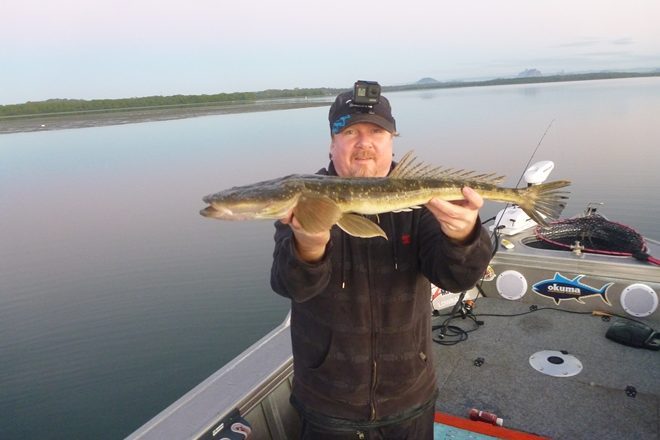
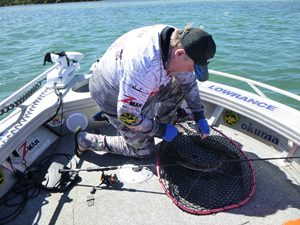

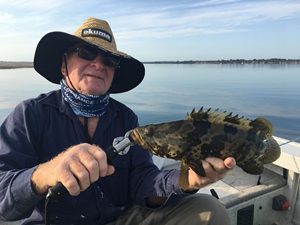
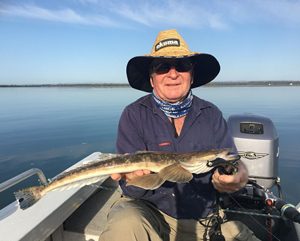

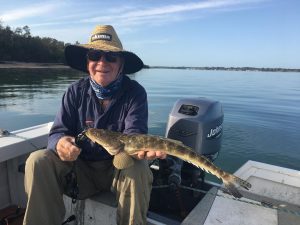
RECENTLY, while taking advantage of the good weather and fishing local rivers and estuaries with soft plastics, we encountered a neap tide or two. A neap tide occurs just after the first or third quarters of the moon, when there is least difference between high and low water, and anglers often use the phrase ‘no run, no fun’ because the bite can be a little slower. Deep flathead
I love flats when targeting bream and flathead, and fishing depths of 0.5-1.5m. However, a neap tide with less run allows me to work deeper edges in the systems I would normally struggle with current a little. Spring also lines up with flathead spawning season, meaning larger numbers of fish can be found along these deeper edges, with solid models in the mix.
We simply locate deeper edges through prior knowledge of the system or with the use of a sounder, and we generally drift or work the edge on the electric motor, targeting banks that drop to 2.5-5m. By doing this, you may also encounter good by-catch such as snapper, estuary cod and mulloway. My go-to technique when fishing this type of structure involves casting a Z-Man 3” MinnowZ onto the edge and hopping the lure down the drop-off, then back to the boat. Deep flathead
This plastic has a good profile for fishing deeper water, appeals to a stack of different species and has loads of action to help the fish locate it. I rig the MinnowZ on a 3/8oz TT Lures Big EyeZ jig head, with Black Glow EyeZ and Chartreuse Red EyeZ a couple of proven favourites. Gear wise, I run 7’ 2-4kg and 3-6kg rods, 20-30 size reels, 10lb braid and 10-15lb Platypus Stealth FC leader.
The 2-4kg rod is fun to fish with, while the 3-6kg is handy when the wind picks up and you really need to punch a cast, and when fishing heavier structure. Key things to look for when selecting edges include rock and rubble, drains coming off the bank, timber, points and other structure that will break the current up, provide ambush points for flathead and attract bait.Deep flathead
It is amazing how often the bank holding the bait is also the bank holding the fish, so keep an eye out for movement in the water and on the sounder. We commonly target the last couple of hours of a run-out tide and the first hour of a run-in. We generally drift a cast distance from the edge, then cast back to the bank slightly ahead of the drift and tight to the edge, where we allow the plastic to sink and hop it back to the boat.
It’s important to give the plastic time to sink and once you get the cast angle right, you should be able to see the line go slack when the soft plastic has hit the bottom. The cool thing about this presentation is that it’s swimming on the drop, so often it won’t even hit the bottom before you feel a tap. If you feel a knock, set the hook – more likely than not, you’ll load up on a solid fish.Deep flathead
If you miss the hook-up, allow the plastic to fall back to the bottom because the fish will often return for another go. I always apply Pro-Cure Super Gel Scent to my plastics, as I want the fish to commit to the strike in deeper water, where feel can be reduced. As mentioned, you will often feel a tap as the fish eats the soft plastic on the drop, otherwise most of your hits will come as you pause the plastic after a few hops or shakes.
It’s also a good idea to fish a couple of different soft plastic colours until you find what fish want to eat on the day, and we mix it up between a dark silhouette, a fluoro and a light natural colour. The first two are our go-to in dirtier water and darker conditions, and the light natural colour is a winner on bright days and in clear water.
Make sure you have a decent sized landing net in case you hook that trophy fish, as well as a set of lip grips to handle the fish in a safe manner for both the fish and yourself, a measure mat to record the length of your catch and a camera or phone to capture the moment. If you haven’t explored the deeper edges in your waterways yet, take advantage of a neap tide and the influx of flathead into many systems.Deep flathead
Get out there and get into them!
See you on the water…
 Bush 'n Beach Fishing Magazine Location reports & tips for fishing, boating, camping, kayaking, 4WDing in Queensland and Northern NSW
Bush 'n Beach Fishing Magazine Location reports & tips for fishing, boating, camping, kayaking, 4WDing in Queensland and Northern NSW
